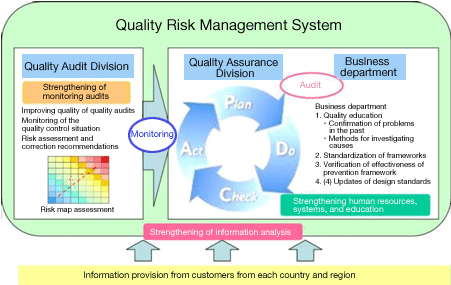KPI
-
Item
Total number of violations of regulations and voluntary standards concerning product safety
-
FY 2016 results
(Consolidated) 0
-
FY 2017 results
(Consolidated) 1
-
Item
Implementation rate of product safety and evaluation (including determination based on compliance with design standards) based on review of design plan for tire products and MB products. FY 2016 results
100%
FY 2017 results
100%
Responsible Departments
Tire Quality Assurance Division (including related products)
MB Quality Assurance Department (products other than tires)
Monitoring by the Quality Audit Department from an internal third-party position
Stance and Target
Why is “Customer Health and Safety” a critical issue to be addressed?
Explanation of the reason and background
If there is a quality issue with tire products or MB products of the Yokohama Rubber Group, it could have a significant impact on the customer’s life, property, or environment. In order to achieve sustainable management, it is important to create trust among customers so that they feel secure in using the products of the Yokohama Rubber Group, and quality issues could lead to a loss of trust from customers. Based on this awareness, the Yokohama Rubber Group has selected customer health and safety as a critical issue to be addressed.
Policies and stance towards handling complaints
Quality Policy
We will contribute to society by planning, designing, producing, and selling attractive products for the satisfaction of our customers while maintaining a quality assurance system in all of our processes, including service.
To this end, we will conduct systematic activities to ensure that all the basic steps in our quality assurance activities function properly.
Response to quality issues calls for preventive measures, prompt prevention of issues spreading after occurrence, and countermeasures to address the source of issues. We conduct risk assessments and countermeasures that put the safety of customers first for all quality issues, while addressing the need to immediately implement measures to prevent issues from spreading, from the perspective of recurrence prevention. In order to achieve this, we share all of the processes from cause investigation to permanent countermeasures in response to quality issues throughout the entire Group, and implement mutual surveillance and horizontal deployment.
Impact assessment on product health and safety implemented in each process
| Process | Impact assessment on product health and safety |
|---|---|
| Impact assessment on product health and safety | In plan examinations, we decide on the target quality in new product development based on existing product quality information and forecasts of customer use conditions, and share points to remember concerning product safety with the related departments. |
| R&D | Through internally stipulated design reviews, we finalize the means and measures for achieving the target quality described above, confirm conformance with the regulations, standards, and certifications of the destination of shipment, and confirm conformance with the customer’s requirements. We only move on to the mass production process once this has been ensured. |
| Manufacturing and production | Legitimacy tests and inspections are conducted to confirm that the target quality has been secured in mass production. The certainty of the effectiveness of our process quality assurance and inspections in each manufacturing process is also maintained through means such as regular internal audits. |
| Marketing and advertisements | In order to ensure product safety, we inform customers and business partners of product handling through means such as catalogs and our website. |
| Storage and distribution | In order to deliver product quality to customers we monitor the storage and distribution process for the presence of defects so that we can achieve improvement measures. |
| Use | We recognize the necessity of explanations and warnings on product use methods, and communicate to spread awareness accordingly. In addition, we endeavor to communicate with customers through customer satisfaction and technology service activities, and we provide feedback to design departments in order to achieve continuous improvements. |
| Disposal, reuse, and recycling | We also conduct control for the retread process for truck and bus tires. |
Measures for vision achievement
In order to further improve the quality activities (PYB management*) we have conducted in the manufacturing process up until now, we will strengthen frameworks for the development of human resources capable of watching over changes in the quality of products released in the market and the prompt communication of such information, and also enhance internal quality audits on a global level in order to confirm that such frameworks are functioning without any issues.
* PYB management: A management system that prevent recurrence in the stages of P (pink, specification), Y (yellow, implementation of improvements), and B (blue, confirmation of effects) when a defect is found in the manufacturing process.
System
For all major quality issues involving products and services provided to customers on a global level, Yokohama Rubber conducts its own risk mapping on what kind of impact defects can have on the customer in all aspects ranging from their self, family possessions, and environment, as well as what kind of potential risks there are, and then analyzes and classifies these risks quantitatively. Based on these results, business quality assurance and service departments ensure the implementation of internal handling that prioritizes customer safety and is prompt, legitimate, and compatible, while the check and monitoring function is fulfilled by the Quality Audit Division.

Response when a problem occurs
If it has been determined that it is not possible to sufficiently ensure customer safety, internal procedures are implemented as quickly as possible, legitimate market measures are adopted, and means such as our website and external media are used to notify customers.
Advance prevention and recurrence prevention
Through the quantitative classification of potential risks in accordance with a quality management system (QMS) and the adoption of a preventive safety design stance based on FMEA*, we are working to establish a framework that ensures that the same kind of quality issue does not occur twice.
While the phenomenon of quality issues differs depending on the business or product, we share cases and countermeasures throughout the Group because there are many similarities in approaches even for different businesses or products, including design approach, risk prediction, environmental consideration, and causes and measures to prevent spreading broken down by each process. As part of this, the Company-wide Quality Problem Recurrence Prevention Report Meeting is held every year concerning the recurrence prevention measures for major quality issues in all businesses in order to confirm the effectiveness of such measures and the status of their cross deployment.
* FMEA (failure mode and effect analysis): Systematic analysis method for potential failures for the purpose of preventing failures and defects.
Implementation of human resource development and seminars for customers
We assign engineers with a wealth of experience to distribution companies and sales bases in markets in Japan and overseas to conduct planned internal training on product knowledge and handling. In addition, we regularly hold seminars in order to increase opportunities for meeting customers to ensure that they handle products safely and properly.
Review of FY 2017 Activities
The number of quality complaints received from customers as a share of all complaints received was reduced by 14% over the previous year in the Tire Group, and by 20% in the MB Group.
In addition, the implementation rate was 100% for internal quality audits for the purpose of ensuring the QMS system based on ISO and IATF, while the implementation rate for external quality audits was also 100%.
Establishment of a quality assurance system
The basis of quality assurance systems in the automotive industry is conformance with IATF16949. For this reason we conduct quality education and promote the acquisition of internal quality auditor certification among managerial and supervisor level employees.
During fiscal 2017, 36 employees were newly certified (total of number of certified employees: 243).
In addition, in order to promote the acquisition of high accuracy market information and rapid response when product defects occur, the Tire Group has implemented a qualification system and formed a service network.
In 2017, 34 staff were newly certified (6 in Japan and 28 overseas) as tires service engineers and 28 staff qualified as authorized adjuster (27 in Japan and 1 overseas) to make judgments regarding complaints.
FY 2017
| Number of staff that has received training and qualifications | In Japan | Overseas |
|---|---|---|
| Number of staff that obtained IATF 16949 internal auditor certification | 36 (cumulative total of 243) | ―― |
| Number of staff which was newly certified as a tire service engineer | 6 | 28 |
| Total number of certified tire service engineer | 1,031 | 497 |
| Number of the authorized adjusters who can make judgements regarding tire complaints (new) | 27 | 1 |
| Total number of authorized adjusters who can make judgements regarding tire complaints | 1,008 | 204 |
Introduction of Initiatives
An issue that occurred in fiscal 2017 is discussed below.
Report on a product quality issue
Voluntary recall information in China and Canada
Due to a problem with part of the production process for passenger car studless tires exported to China and Canada, certain tires may have insufficient input of a compounding agent for the under tread layer. This could cause a portion of the tire tread to swell and bulge during driving. If the vehicle is operated with this condition, the bulge area may peel off which could affect steering stability. For these reasons, a voluntary recall is conducted in both China and Canada, and affected tires are being recalled.
Issues and Future Improvement Measures
In order to eradicate quality issues, provide products that clearly address customer needs, and achieve safety, legitimacy, and compatibility, we have deployed a service network around the world to gather, analyze, and classify the voices of customers as part of a cycle that ensures such voices are incorporated into new products.
Going forward, in order to pursue the provision of products that will satisfy the needs and use environments of customers, one important issue is being sure to listen sincerely to information about complaints from customers and work to steadily reduce the number of complaints. In order to achieve this, we will work to strengthen our market quality information gathering capabilities and promote market adaptability in each market through service departments and customer contact points.
Quality assurance at partner companies is also an extremely important challenge for us. For this reason, we are implementing certain self-check frameworks based on the clarification of responsibilities and past problems, as well as audits of partner companies.

